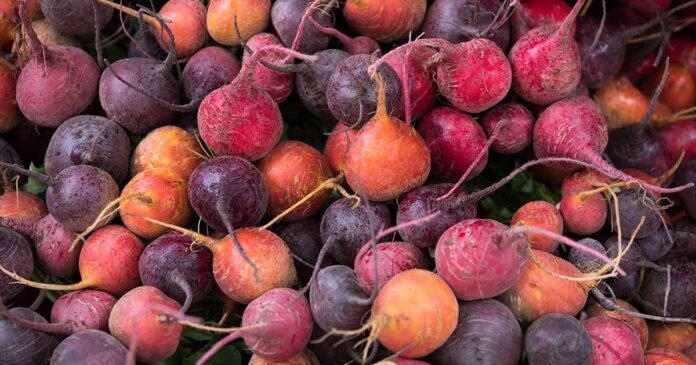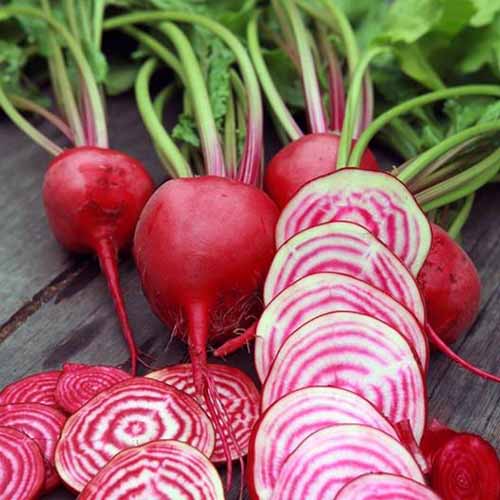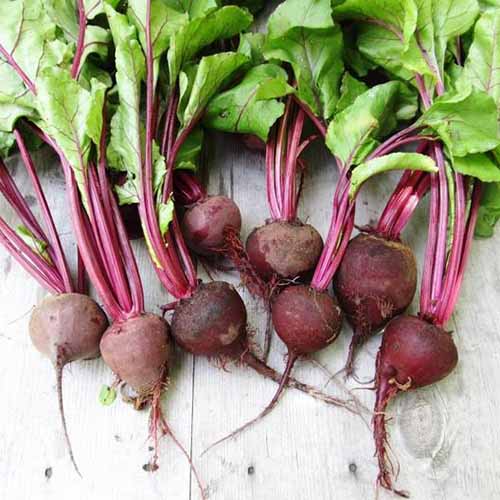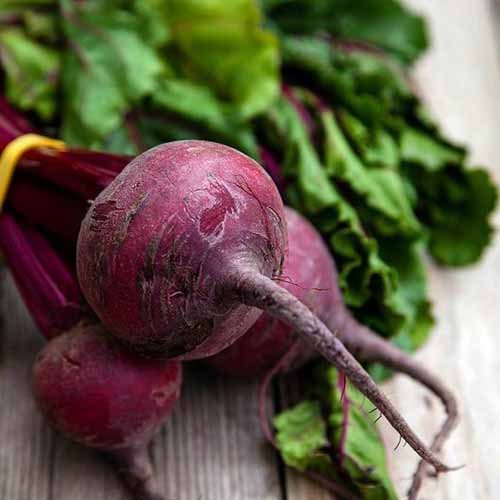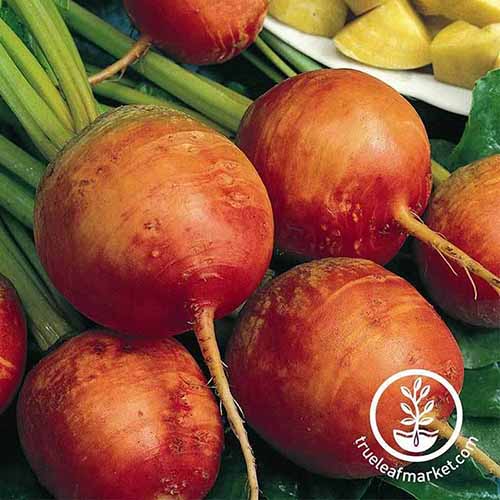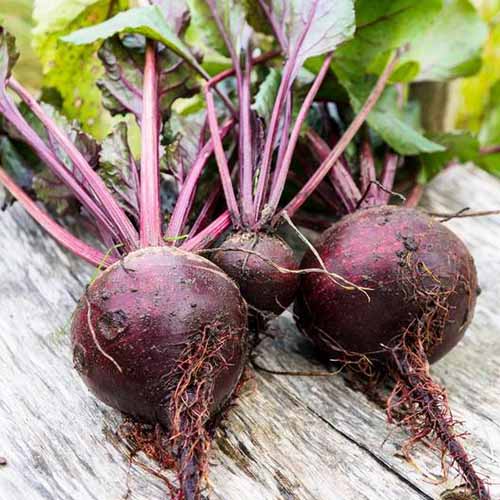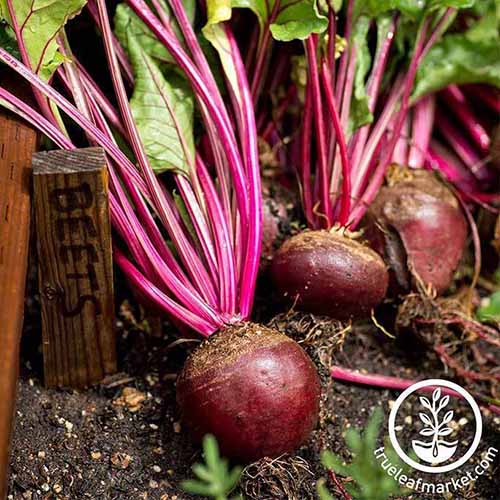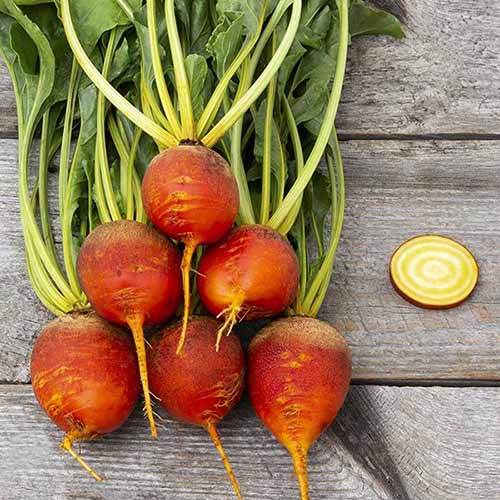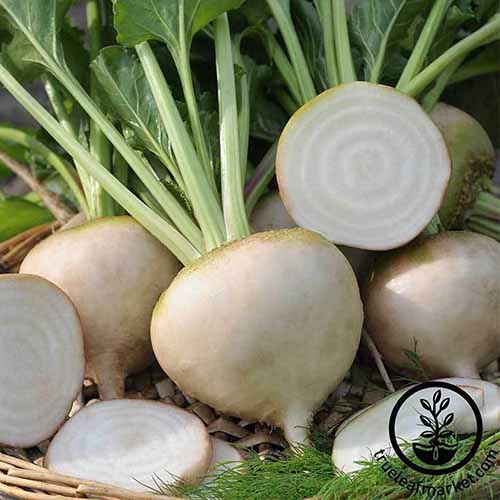If you’re shopping around for white varieties to plant, you may come across some seed packets labeled as either “sugar” or “forage” beets, possibly sold at a bulk or wholesale price.
That’s because white beets are grown commercially either for processing into sugar or for use as livestock feed.
Both can be eaten like any other type of beet when the roots are young and small, and their greens are delicious.
Ready to dig in?
1. Avalanche
‘Avalanche’ is an open-pollinated white cultivar with a sweet, mild flavor.
An All-America Selections winner in 2015, the creamy-white roots have all the sweetness of a red beet with no hint of bitterness.
The mild flavor and crunchy texture makes them ideal for slicing raw in salads, and they are delicious roasted or added to soups and stews.
‘Avalanche’ will convert even the most vocal beet-haters in your family into fans. My tip: pretend it’s not a beet when you prepare these.
Another advantage? You don’t have to worry about red stains all over your hands and chopping board!
Round roots are best harvested when they are two to three inches in diameter, after about 50 days. The light green tops can be enjoyed sauteed as a side dish.
You can find seeds available at Burpee.
2. Boldor
‘Boldor’ is an open-pollinated golden beet that matures in 55 to 60 days.
It produces smooth, round roots about three to four inches across with bright golden flesh that keeps its color when cooked.
Upright, pale green tops with golden stems add ornamental appeal and are good for cooking as greens.
The roots are tender and sweet, excellent for roasting, juicing, or enjoying fresh in salads.
You can find seeds available from High Mowing Organic Seeds in a variety of packet sizes.
3. Boltardy
Maturing in about 60 days, ‘Boltardy’ holds the Royal Horticultural Society’s Award of Garden Merit.
Roots are deep crimson, round, and roughly two and a half to three inches across.
This heirloom variety is highly bolt-resistant, making it perfect for early spring sowing or succession planting.
The flavor is sweet and fine-textured, ideal for canning, pickling, or slicing raw in salads.
Pick up ‘Boltardy’ seeds in a variety of package sizes from True Leaf Market.
4. Boro
‘Boro’ is a fast-maturing hybrid that delivers smooth, dark-red roots in just 50 days.
The roots measure about two to six inches across at harvest and have deep red flesh with high juice content.
Above the ground, vigorous upright tops make a good, edible cut-and-come-again green.
With crisp texture and mild sweet flavor, the roots are excellent for roasting, grilling, or adding color to salads.
You can find ‘Boro’ seeds available in a variety of packet sizes from High Mowing Organic Seeds.
5. Bull’s Blood
This heirloom cultivar was developed from the French variety ‘Crapaudine’ and introduced in 1986.
Deep purple leaves can be harvested as microgreens to add color to salads, or sauteed like Swiss chard.
Roots are deep red, with a sweet, slightly earthy flavor and no hint of bitterness – especially when harvested young.
Roots mature in 55 days and tops can be harvested after just 30 days.
You can find seeds available at Eden Brothers.
6. Chioggia
Also known as ‘Candystripe,’ ‘Dulce di Chioggia,’ or ‘Bull’s Eye,’ this eye-catching heirloom cultivar takes its name from a small fishing town near Venice, in Italy.
From the outside, it has an unremarkable, round “beety” look. But slice it open and ‘Chioggia’ reveals concentric rings of pink and white.
With a delicate, sweet flavor, the unusual pattern adds a pop of color to salads. Cooking causes the ring pattern to fade.
Crispy greens can be harvested after 50 days, but wait 60 days to pull the three- to four-inch candy-cane striped beauties out of the ground.
You can find seeds available at Eden Brothers.
7. Crosby Egyptian
‘Crosby Egyptian,’ sometimes listed as ‘Crosby’s Egyptian,’ is an heirloom cultivar that originated in Germany and was brought to the US as ‘Egyptian Beet’ in the 1860s.
Josiah Crosby, a market gardener in Boston, developed ‘Crosby Egyptian’ with its wide, three- to five-inch early maturing root. It first appeared in James Gregory’s seed catalog in 1880.
The roots have a flattened shape and a sweet yet slightly earthy flavor. Green tops with red stems are delicious harvested young for salads, or sauteed as mature greens.
Quick to mature in just 55 days, plants are known for being cold-tolerant and are ideal for northern gardeners who want an early fall crop.
Find seeds now at Eden Brothers.
8. Cylindra
‘Cylindra’ is an heirloom cultivar, ideal for pickling and canning. Elongated roots with smooth skin and deep red flesh have a sweet, mild flavor with just the slightest hint of earthiness.
The smooth-textured roots grow six to eight inches long and an inch or two in diameter. Sometimes known as ‘Butter Slicer,’ the uniform width is ideal for slicing.
Enjoy ‘Cylindra’ roasted, added to soups and stews, or go old-school and pickle slices in vinegar to the horror – or delight – of your family.
The leaves are reddish-green and have a slightly bitter flavor if eaten raw.
Roots mature in 60 to 70 days, and tops can be harvested after just 35 days. ‘Cylindra’ is ideal for growing in the smaller garden as the plants take up less space.
Seeds are available at Eden Brothers.
9. Detroit Dark Red
This classic heirloom variety was first introduced in 1892 by D. M. Ferry Seed Company as ‘Detroit Dark Red Turnip.’
But it’s not a turnip, it’s a beet. Deep red, rounded roots with smooth skin are sweet, mild, and tender, ideal for canning, roasting, and slicing raw in salads.
The tops are tender and flavorful, too, with dark green leaves and bright red stems and veins. Harvest baby greens for a pop of nutritious color in salads.
You can harvest the three-inch roots after 60 days, but the greens will delight your palate after just 35 days.
Find seeds available at Eden Brothers.
10. Early Wonder
Also known as ‘Boston Crosby’ and ‘Nuttings Gem,’ ‘Early Wonder’ is, well, an early-maturing heirloom cultivar first introduced to the US in 1911.
This variety is ideal for those who want to harvest abundant greens as well as delicious roots.
The deep red roots are round with a slightly flattened top, and have a sweet, mild flavor.
The tops are particularly fast-growing and have a lightly piquant taste, particularly when harvested as baby greens.
Two to three-inch roots will be ready for harvest after just 50 days, and plants are heat and cold tolerant.
11. Formanova
‘Formanova’ is an open-pollinated cylindrical beet that matures in about 54 days.
The roots grow five to six inches long and one to two inches wide, making them ideal for uniform slicing and canning.
Upright, vigorous tops offer extra greens for fresh use. The long, smooth roots are tender and sweet, perfect for roasting, pickling, or slicing thin for salads.
Grab packets of seeds in a variety of sizes at High Mowing Organic Seeds.
12. Golden
If you want to trick your recalcitrant family into enjoying beets but aren’t tempted by the white varieties, then roast up some ‘Golden’ roots with a delicate balsamic glaze.
Also known as ‘Burpee’s Golden,’ this heirloom cultivar was introduced – you guessed it – by the Burpee Seed Company in 1970.
Glorious two-inch golden globes with yellow flesh and a sweet, mild flavor mature in just 55 days. Tender green leaves with yellow stems can be harvested after 40 days.
You can find seeds available at Burpee.
Find more tips on growing golden beets here.
13. Golden Detroit
Sweet and mild, heirloom cultivar ‘Golden Detroit’ produces one to three-inch oval shaped orange-yellow roots that are delicious both raw and cooked.
Light green tops with pale stems have no hint of bitterness and are an ideal addition to summer salads.
Roots mature after 55 days. Leaves can be harvested after 40 to 45 days.
Seeds are available at True Leaf Market.
14. Guardsmark
‘Guardsmark’ is a beautiful Chioggia beet that matures in about 55 days.
The flat, globe-shaped roots measure approximately two to three inches across and reveal stunning concentric rings of red and white when sliced.
Tops are medium height, with green leaves and pale-pink stems. With its mild, sweet flavor and eye-catching interior, it shines roasted, pickled, or fresh in salads.
Find ‘Guardsmark’ seeds in a variety of packet sizes at High Mowing Organic Seeds.
15. Lutz Green Leaf
If you like a big root for tossing in your root cellar (do you have a root cellar? If so, I’m jealous!) and a harvest that will see you through the most miserable of winters, then try ‘Lutz Green Leaf,’ aka ‘Winterkeeper.’
You’ll be able to enjoy the six-inch, deep-red tubers pickled, roasted, tossed into soups and stews – and even in salads.
The greens are indeed “green,” and are delicious sauteed in butter and garlic, with a flavor that’s comparable to Swiss chard.
If you want ‘em big, leave them to mature for the full 65 days, or pull them early for baby beets if you really have to.
You can find seeds at Eden Brothers.
16. MacGregor’s Favorite
A rare heirloom from Scotland, ‘MacGregor’s Favorite’ is appreciated more for its glowing bronze‑red, glossy leaves than its roots.
It matures in 55 to 65 days and develops slender, tapering roots. The foliage arches gracefully, adding ornamental value to edible borders or containers.
Use the leaves cooked like chard or stir-fried, and enjoy the roots fresh as baby beets.
Pick up packets of seeds from True Leaf Market.
17. Merlin
Probably the sweetest of the red-rooted beets, ‘Merlin’ is an F1 hybrid cultivar bred for high sugar content, disease resistance, and both heat and cold tolerance.
In other words, you don’t need to be a gardening wizard to grow these.
Crisp when raw, and delectably tender when cooked, ‘Merlin’ will enchant with his exceptional sweetness. Even the glossy, dark green tops are delicious.
Three to four-inch perfectly round roots are ready to harvest after 55 days, and you can enjoy the crimson-stemmed greens after 30 to 40 days.
Seeds are available at Burpee.
18. Moulin Rouge
‘Moulin Rouge’ is a hybrid cultivar with deep magenta roots that you cancan enjoy both fresh or cooked.
With a rich and succulent texture, one- to two-inch globes of gloriousness have a sweet, rich, “beety” flavor.
Baby roots can be harvested after just 35 days, or leave them in the ground for 55 to 60 days for mature roots.
You can find seeds from Burpee.
19. Red Ace
Calling all Star Wars fans, this one’s for you. Make Freya Fenris jealous and grow your very own ‘Red Ace’ spaceship in the comfort of your own garden.
An F1 fighter jet – sorry, I mean hybrid – an F1 hybrid variety, ‘Red Ace’ is a fast-maturing beet adaptable to a wide range of soil conditions, and is more cold-tolerant than other cultivars.
Smooth-skinned, deep purple, three-inch globes will push up through the soil in just 50 days. Cut them open and the scarlet flesh reveals clear concentric rings, with a mild yet hearty flavor.
Seeds are available from True Leaf Market.
20. Red Ball
Also known as ‘Burpee’s Red Ball,’ this heirloom cultivar has sweet, mild, red flesh and deep purple, smooth skin. Uniformly round three-inch roots are ready for harvest after 60 days.
This variety produces an abundance of particularly tasty greens, which you can harvest young for salads, sautes, and stir-fries.
You can find seeds available at Burpee.
21. Rhonda
‘Rhonda’ is a hybrid that matures in about 65 to 70 days.
The smooth, round roots measure approximately two to three inches across and retain their deep red color and sweet flavor even through extended storage.
It develops robust, upright foliage and delivers uniform roots that are ideal for harvesting in fall and storing well into winter.
The sweet, tender roots are excellent roasted, pickled, or sliced fresh into salads.
Find ‘Rhonda’ seeds available at High Mowing Organic Seeds in a variety of packet sizes.
22. Ruby Queen
‘Ruby Queen,’ an heirloom cultivar, was crowned an All-America Selection winner in 1957.
She grows happily in poor soil, and her perfectly round, two to three-inch deep-red roots are especially suitable for canning, with a sweet, mild flavor and toothsome texture.
Her short tops grow to just 10 to 12 inches tall, and roots can be harvested after just 55 days.
Find your seeds from Eden Brothers.
23. Shiraz
An open-pollinated red variety, ‘Shiraz’ matures in 50 to 55 days.
The smooth, round roots are about three inches across with deep burgundy flesh and consistent color.
Upright, glossy green tops with red stems reach 12 to 14 inches and make excellent greens.
Bred for strong disease resistance, including Cercospora leaf spot, this variety holds well in the field and maintains sweet, earthy flavor whether roasted, pickled, or eaten fresh.
Pick up ‘Shiraz’ seeds from High Mowing Organic Seeds in your choice of packet sizes.
24. Subeto
An early-maturing hybrid, ‘Subeto’ is ready in about 50 days.
With deep red, spherical roots roughly three inches across with fine taproots and consistently smooth skin, ‘Subeto’ is perfect for uniform harvests.
The plants develop upright tops and are well-suited to close spacing, making them efficient in smaller beds.
The roots are crisp, sweet, and retain color through cooking, excellent sliced raw, pickled, or roasted.
You can find packets of ‘Subeto’ seeds in a variety of sizes at High Mowing Organic Seeds.
25. Touchstone Gold
‘Touchstone Gold’ is a popular golden hybrid variety, and seeds have an above-average germination rate.
Bright yellow flesh with smooth deep-orange skin is sweet and mild when eaten raw or cooked.
Three-inch roots display clear concentric rings when sliced, and these are ready for harvest after 55 days.
Light green tops with yellow stems are tender and ideal for adding to salads or stir-fries.
You can find seeds available from High Mowing Seeds.
26. Vereduna Alba
‘Vereduna Alba’ is an open-pollinated white variety ready to harvest in about 55 days.
It produces smooth, round roots about three inches across with creamy white flesh and a mild taste, less earthy than red varieties.
The skin may show a faint pink blush, while the leafy tops are sturdy and wavy.
This variety resists Cercospora leaf spot and is excellent raw, pickled, or cooked, adding subtle flavor and color contrast in the kitchen.
Find seeds available at High Mowing Organic Seeds in a variety of packet sizes.
27. White Detroit
With all the distinctive taste of a red beet but no staining, ‘White Detroit’ has creamy-white, three-inch roots with a sweet yet hearty flavor.
This heirloom cultivar matures in 55 days and roots can be harvested early for baby beets.
Light green tops are ideal for stir fries and sautes.
Find seeds now at True Leaf Market.
Beets for Everybody!
Is your head spinning from all the choices?
There are quite a few, but when you consider the attributes you’re seeking – flavor, color, timing – you ought to be able to find one or two (or six…) that will be just right for your family!
Remember to read our beet growing guide to get started.


And if you’re not already a family of beet eaters, wouldn’t you just love to introduce a new vegetable to your kids?
We’d love to hear which varieties you’ve tried and how they worked out for you. Tell us what part of the country you live in, and share your beet tales in the comments section below!
And for more information about growing beets, check out these guides next:


